 полная версия
полная версияNatural History of the Mammalia of India and Ceylon
"Poets are not always correct. Tigers have often been tamed, though they are not to be depended on."
Now we come to the true Lynxes, which are cats with very short tails, long limbs, tufted ears, the cheeks whiskered almost as long as Dundreary's, and feet the pads of which are overgrown with hair. Some naturalists would separate them from the other cats, but the connection is supplied by the last species which, though possessing certain features of the lynx, yet interbreeds with the true cats. The lynx was well known to the ancients, and was one of the animals used in the arena from its savage disposition, and its sight was considered so piercing as to be able to penetrate even stone walls! There are no true lynxes in India proper; we must look to the colder Trans-Himalayan countries for them. The following is from Thibet:—
NO. 217. FELIS ISABELLINAThe Thibetan LynxHABITAT.—Thibet.
DESCRIPTION.—"Pale isabella-brown, with scarcely a trace of markings, but in some the spots come out even conspicuously in summer pelage, especially on the limbs and belly, and the crown and middle of the back are generally more or less infuscated, occasionally very much so; in some the face is almost white, with traces of frontal streaks, and there is always (the same as in the European lynx) a short, narrow, dark streak on each side of the nose towards its tip."—Blyth.
This species is similar in some respects to the European animal, but the principal difference lies in the feet, the pads of which in the Thibetan species are prominent and bare, with short, close fur between them, whereas in the European lynx the long fur completely conceals the pads, and the latter is the larger animal. There is a very good photograph of F. isabellina in Kinloch's 'Large Game Shooting in Thibet and the North-West,' taken from a carefully stuffed specimen. The author says: "On the 4th of July 1866, I was hunting Oves Ammon on the high ground between Hanle and Nyima, when I suddenly came upon a female lynx with two young cubs. I shot the mother, and as the cubs concealed themselves among some rocks, I barricaded them in, and went on with my hunting. On arriving in camp I sent men back to try and catch the cubs; in this they succeeded, and brought them to me. They were about the size of half grown cats, and more spiteful vicious little devils cannot be imagined; they were, however, very handsome, with immense heads and paws. For two or three days they refused all food; but at the end of that time they fed quite ravenously from the hand. They soon became very tame and playful, though always ready to set their backs up if at all teased, or if a dog came near them."
The next species differs from the typical lynx in wanting the ruff of hair round the face, and also in having the pads of the feet bald. The skull is that of a lynx, but the processes of the frontals and intermaxillæ are not quite so much produced, and they do not entirely separate the nasal from the maxillæ. There is a good illustration to be found in De Blainville's 'Ostéographie.'
NO. 218. FELIS CARACALThe Red Lynx (Jerdon's No. 116)NATIVE NAME.—Siagosh, Persian, i.e., black ear.
HABITAT.—Scattered throughout India generally, Assam (Burmah and Ceylon?), but it has also a much wider range, being found throughout Africa, Syria, and Arabia, and also in Persia.
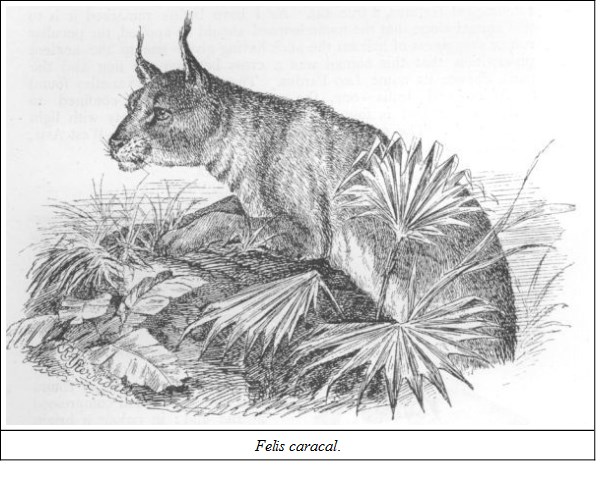
DESCRIPTION.—Colour sandy fulvous, varying somewhat in individuals; paler beneath, in some almost white; tail the same colour as the body, with a black tip; the lower parts with some obscure spots, more or less distinct on the belly, flanks and insides of limbs; ears black externally, with a long dark ear tuft, white inside; a small blackish spot on the upper lip, and another above the eye, also a line down each side of the nose. In some individuals faint bars and caudal rings are discernible, and the chest is obscurely banded.
SIZE.—Head and body, 26 to 30 inches; tail, 9 or 10; height, 16 to 18 inches.
This handsome lynx is found, though not very common, in most parts of the Indian Peninsula, although Jerdon states that it is unknown in the Himalayas, Bengal, and the eastern countries. In those parts where it abounds it is very destructive to small game, such as gazelles, the smaller deer and hares. It also catches such birds as pea-fowl, florican, cranes, &c., frequently springing at them from the ground as they fly over. They are easily tamed. I had a young one at Seonee, and the natives of some parts are said to train them for sporting purposes in the manner in which the hunting leopard is trained.
Blyth says a brace of siagosh are often pitted against each other by the natives who keep them, a heavy wager pending as to which of the two will disable the greater number out of a flock of tame pigeons feeding, before the mass of them can rise out of reach, and ten or a dozen birds are commonly struck down right and left.
"It is a most sanguinary creature, yet the keepers manage them with facility, and slip the hood over their eyes with extreme dexterity, while they are engaged with their prey. In general they become quite tame to persons they know, and often sufficiently so to bear handling by a stranger. Much as I have seen of them I never heard one utter a sound, except hissing and growling."
With regard to this last assertion of Mr. Blyth's I may say that the caracal differs very much from the European lynx, who, according to Tschudi, betrays his presence by horrible howlings audible at a great distance. Professor Kitchen Parker writes that the specimen now in the Zoological Gardens is a most cantankerous beast.16 "If the American lynx, who is unfortunate enough to live in the same cage with him, dares to come betwixt the wind and his nobility, or even if he, in the course of his peregrinations, should, by chance, get sufficiently near his companion to be annoyed with the sight of so vulgar a beast, he immediately arches his back, lays back his ears, uncovers his great canines, and swears in a most fearful manner until the other unlucky animal is quite cowed, and looks as meek as its feline nature will allow it, evidently deprecating the anger of my lord; and although not conscious of having done wrong, quite ready to promise faithfully never to do it again."
We now take up the last member of the Cat family; one differing so much in certain respects as to have been classed by some authors as a separate genus, to which Wagner gave the name of Cynælurus, or dog-cat, which, however, is not appropriate, as the animal, though having the slender form of the greyhound, and in having the claws of its middle front toes but imperfectly retractile, is, in its anatomy and all osteological features, a true cat. As I have before remarked it is to this animal alone that the name leopard should be applied, the peculiar ruff or shagginess of hair on the neck having given rise to the ancient superstition that this animal was a cross between the lion and the pard, whence its name Leo-Pardus. There are three varieties found in Africa and India—one, the maneless leopard, is confined to Africa, where also is found in the south a woolly variety with light brown spots. The maned leopard is found all over South-West Asia, including India.
NO. 219. FELIS JUBATAThe Hunting Leopard (Jerdon's No. 117)NATIVE NAMES.—Chita, Hindi; Yuz of the Chita-catchers; Kendua-bagh, Bengali; Laggar in some parts; Chita Puli, Telegu; Chircha and Sivungi, Canarese.
HABITAT.—Central or Southern India, and in the North-West from Kandeish, through Scinde and Rajpootana, to the Punjab. It is also found in all Africa, with Syria and Arabia, and throughout Asia Minor. In India the places where it is most common are Jeypur in Upper India, and Hyderabad in Southern India.
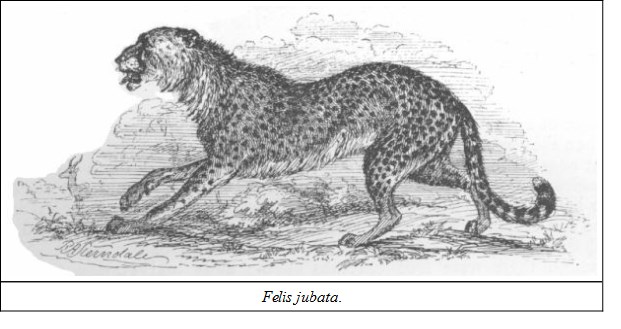
DESCRIPTION.—A tall, slim animal, with body much drawn in at the flanks like a greyhound; purely cat-like head with short round ears; long tail, much compressed at the end; in colour a bright rufous fawn, more or less deep, sometimes what Blyth calls a bright nankeen, dotted with numerous small black spots which are single, and not in rosettes, as in the pards; a black streak from the corner of the eye down the face; ears black at base externally, the rest whitish; the tail spotted, but having three or four black rings at the tip: the extreme tip is always white; the hair of the belly is lengthened with a shaggy fringe-like appearance; the fur generally is coarse; the nozzle is black, whereas in the tiger it is pink, and in a pard dusky pink; the pupils of the eye contract circularly.
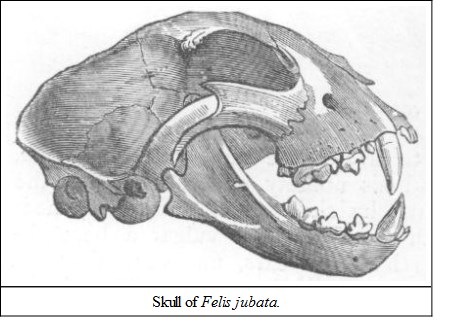
SIZE.—Head and body, about 4½ feet; tail, 2½; height, 2½ to 2¾ feet.
This animal is one of the most interesting of all the felines, both as regards its appearance, disposition, habits, and the uses to which it can be put. Throughout India it is in much request as a necessary appanage to regal state; and, therefore, a class of men devote themselves to the trapping of this creature which, when trained, finds a ready sale at the courts of Indian nobles. For this purpose the adult animal is always caught, it being considered by the chita-catchers that a young leopard would never turn out well for the purposes of the chase. A similar idea prevails amongst the falconers of Hindustan regarding nestlings, and it is surprising how soon a large adult and apparently savage animal can be reduced to a state of comparative slavery and obedient to the orders of his keepers.
Dr. Jerdon describes one which he brought up from its earliest infancy; his bungalow was next to the one I inhabited for a time at Kampti, and consequently I saw a good deal of Billy, as the leopard was named. At my first interview I found him in the stables amongst the dogs and horses, and, as I sat down on his charpoy, he jumped up alongside of me, and laid down to be scratched, playing and purring and licking my hands with a very rough tongue. He sometimes used to go out with his master, and was gradually getting into the way of running down antelope, when Dr. Jerdon was ordered off on field service.
The mode of hunting with the chita is so well known, and has been so frequently described, that I think I need not attempt a description. Its habits in a state of nature, and the mode of capture, are more to the purport of this work. It is said by shikarees to feed only once every third day, when, after gorging itself, it retires to its den for the other two. On the morning of the third day he visits some particular tree, which the animals of his species in the neighbourhood are in the habit of frequenting. Such trees are easily to be recognised by the scoring of the bark on which he whets his claws. Here, after having relieved himself in various ways and played about with such of his comrades as may be there, they go off on a hunting expedition.
There is an interesting letter from "Deccanee Bear" in The Asian of the 22nd of July, 1880, giving a description of the snaring of some of these animals, and the remarks he makes about their rendezvous at a particular tree, corroborates what has been asserted by other writers. He says: "Arrived at the spot the bullocks were soon relieved of their burden, and then work commenced. The nooses were of the same kind as those used for snaring antelope, made from the dried sinews of the antelope. These were pegged down in all directions, and at all angles, to a distance of 25 to 30 feet from the tree. The carts and bullocks were sent off into a road about a mile away. An ambush was made of bushes and branches some fifty or sixty yards away, and here, when the time came, I and three Vardis ensconced ourselves. I have sat near some dirty fellows in my life, but the stench of those three men baffles description; you could cut it with a knife. I could not smoke, so had to put up with the several smells until I was nearly sick. At last the sun commenced to sink, and the men who were looking round in all directions, suddenly pointed in the direction of the north. Sure enough there were four cheetahs skying away and playing together about 400 yards off; they came closer and closer, when they stopped about 100 yards off, looking about as if they suspected danger. However, they became reassured, and all raced away as hard as they could in the direction of the tree. Two were large and the other two smaller; the larger had the best of the race, and were entangled by all four feet before they knew where they were. The Vardis made a rush. I did the same, but in a second was flat on the ground, having caught my feet in the nooses. One of the men came and released me from my undignified position, and I could then see how the cheetahs were secured. A country blanket was thrown over the heads of the animal, and the two fore or hind legs tied together. The carts had come up by this time; a leather hood was substituted for the blanket—a rather ticklish operation, during which one man was badly bitten in the hand. The cheetahs know how to use their teeth and claws. Having been securely fastened on the carts, and the nooses collected, we started for camp, which we reached about eight in the evening. I was much pleased with what I had seen and learnt, but it took me a long time to get the smell of the Vardis out of my head. The next morning I went to see the cheetahs and found that they had been tied spread-eagle fashion on the carts, and with their hoods firmly tied. They were a pair, and in all probability the parents of the two smaller ones. Women and children are told off to sit all day long close to the animals, and keep up a conversation, so that they should get accustomed to the human voice. The female was snarling a good deal, the male being much quieter; they go through various gradations of education, and I was told they would be ready to be unhooded and worked in about six months' time. The man who had his hand bitten was suffering from considerable inflammation. I had him attended to, and, after rewarding them with 'baksheesh,' I let them proceed on their way rejoicing."
Chita kittens are very pretty little things, quite grey, without any spots whatever, but they can always be recognised by the black stripe down the nose, and on cutting off a little bit of the soft hair I noticed that the spots were quite distinct in the under fur. I have not seen this fact alluded to by others. As a rule the young of all cats, even the large one-coloured species, such as the lion and puma, are spotted, but the hunting leopard is externally an exception, although the spots are there lying hid. I had several of them at Seonee.
HYÆNIDÆ—THE HYÆNASThe second family of the Æluroidea contains only one genus, the Hyæna, which, though somewhat resembling the dog in outward appearance, connects the cat with the civet. The differences between the Felidæ and the Viverridæ, setting aside minor details, are in the teeth, and the possession by the latter of a caudal pouch. My readers are now familiar with the simple cutting form of the feline teeth, which are thirty in number. The civets have no less than forty, and the grinders, instead of having cutting scissor-like edges, are cuspidate, or crowned with tubercles. Now the hyæna comes in as an intermediate form. He has four more premolars than the typical cat, and the large grinding teeth are conical, blunt and very powerful, the base of the cone being belted by a strong ridge, and the general structure is one adapted for crushing rather than cutting. Professor Owen relates that an eminent engineer, to whom he showed a hyæna's jaw, remarked that the strong conical tooth, with its basal ridge, was a perfect model of a hammer for breaking stones.
Of course, such a formation would be useless without a commensurate motive power, and we may, therefore, look to the skull for certain signs of the enormous development of muscles, which this animal possesses. In shape it somewhat resembles the cat's skull, though not so short, nor yet so long as that of the civet or dog. The zygomatic arches are greatly developed, also the bony ridges for the attachment of the muscles, especially the sagittal or great longitudinal crest on the top of the head, which is in comparison far larger than that of even the tiger, and to which are attached the enormous muscles of the cheek working the powerful jaws, which are capable of crushing the thigh-bone of a bullock. Captain Baldwin, in his book, says he remembers once, when watching over a kill, seeing a hyæna, only some twelve feet below where he sat, snap with a single effort through the rib of a buffalo.
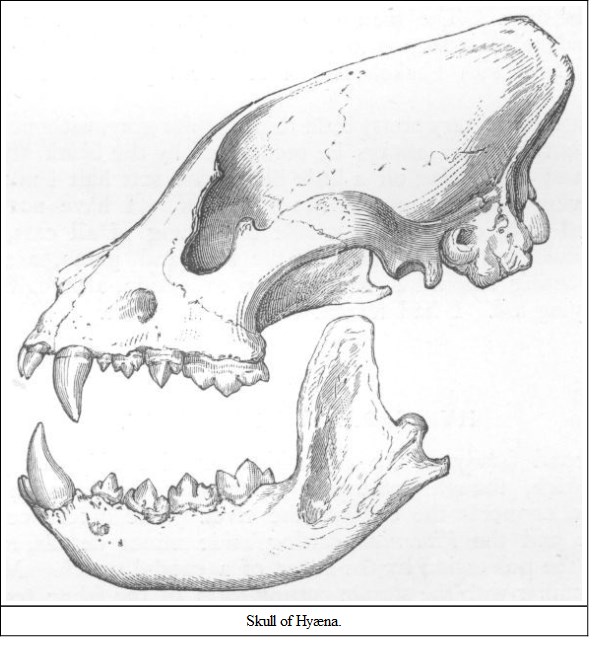
The hyæna also possesses the sub-caudal pouch of the civets, which gave rise amongst the ancients to various conjectures as to the dual character of its sex.
The bulla tympani or bulb of the ear is large as in the cats, but it is not divided into two compartments by a bony partition (which in the dogs is reduced to a low wall), but the paroccipital process or bony clamp on the external posterior surface is closely applied to the bulb as in the cats, and not separated by a groove as in the dogs.
The cervical vertebræ sometimes become anchylosed, from whence, in former times, arose the superstition that this animal had but one bone in the neck.
In its internal anatomy, digestive as well as generative, the hyæna is nearer to the cat than the dog, but it possesses the cæcum, or blind gut, which is so large in the canidæ, small in the felines, and totally absent in the bears.
The tongue is rough, with a circular collection of retroflected spines. The hind legs are much shorter than the front, and the feet have only four toes with blunt worn claws, not retractile, but like those of the dog.
The hair is coarse and bristly, and usually prolonged into a sort of crest or mane along the neck and shoulders, and to a slighter degree down the back; the tail is bushy.
Dental formula: Inc., 3—3/3—3; can., 1—1/1—1; premolars, 4—4/3—3; molars, 1—1/1—1.
There are only three known species of hyæna, of which one, our common Indian animal, belongs to Asia, and two, H. crocuta and H. brunnea, to Africa.
GENUS HYÆNANO. 220. HYÆNA STRIATAThe Striped Hyæna (Jerdon's No. 118)NATIVE NAMES.—Taras, Hundar, Jhirak (in Hurriana); Lakhar-baghar, Lokra-bagh, Hindi; Naukra-bagh, Bengali; Rerha in Central India; Kirba and Kat-Kirba, Canarese; Korna-gandu, Telegu.
HABITAT.—All over India; but as far as I can gather not in Burmah nor in Ceylon; it is not mentioned in Blyth's and Kellaart's catalogues. It is also found in Northern Africa and throughout Asia Minor and Persia; it is common in Palestine.
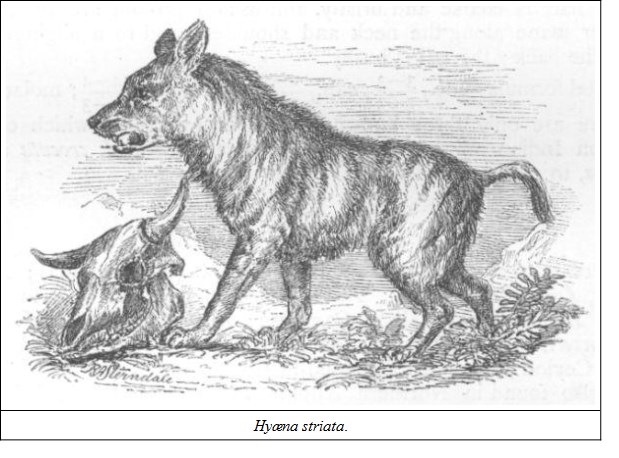
DESCRIPTION.—Pale yellowish-grey, with transverse tawny or blackish bands which encircle the body, and extend downwards on to the legs. The neck and back are maned.
SIZE.—Head and body, 3½ feet; tail, about 1½ feet.
This repulsive and cowardly creature is yet a useful beast in its way. Living almost exclusively on carrion, it is an excellent scavenger. Most wild animals are too active for it, but it feeds on the remains left by the larger felines, and such creatures as die of disease, and can, on a pinch, starve for a considerable time. The African spotted hyæna is said to commit great havoc in the sheep-fold. The Indian one is very destructive to dogs, and constantly carries off pariahs from the outskirts of villages. The natives declare that the hyæna tempts the dogs out by its unearthly cries, and then falls upon them. Dr. Jerdon relates a story of a small dog belonging to an officer of the 33rd M. N. I. (the regiment he was with when I first knew him) being carried off by a hyæna whose den was known. Some of the sepoys went after it, entered the cave, killed the hyæna, and recovered the dog alive, and with but little damage done to it.
The hyæna is of a timorous nature, seldom, if ever, showing fight. Two of them nearly ran over me once as I was squatting on a deer run waiting for sambar, which were being beaten out of a hill. I flung my hat in the face of the leading one, on which both turned tail and fled. The Arabs have a proverb, "As cowardly as a hyæna."
The Cryptoprocta ferox is not an inhabitant of India, being found only in the interior of Madagascar. The genus contains only one species, a most savage little animal; it is the most perfect link between the cats and the civets, having retractile claws, one more premolar in each jaw; five toes, and semi-plantigrade feet. It should properly come before the hyænas, to which the next in order is the South African Aard-wolf (Proteles Lalandii), which forms the connection between the hyæna and the civet, though more resembling the former. It is placed in a family by itself, which contains but one genus and species. It has the sloping back of the hyæna, the hind legs being lower than the fore, and it might almost, from its shape and colouring, be taken for that animal when young. The skull however is prolonged, and the teeth are civet-like. It is nocturnal and gregarious, several living in the same burrow. Like the hyæna it lives on carrion. It has a fifth toe on the fore feet.
VIVERRIDÆ—THE CIVET FAMILYThe Civets are confined to the Old World; they are mostly animals with long bodies, sharp muzzle, short legs, long tapering tail and coarse fur; they are semi-plantigrade, walking on their toes, but keeping the wrist and ankle nearer to the ground than do the cats; the claws are only partially retractile; the skull is longer in the snout than that of felines, and, altogether narrower, the zygomatic arches not being so broad, the base of the skull is much the same, and the bulla tympani shews little difference; the teeth, however, are decidedly different. There are four premolars and two molars on each side of each jaw, which, with the normal number of canines and incisors, give forty teeth in all; the canines are moderate in size, and sharp; the premolars conical, and the molars cuspidate, which gives them a grinding surface instead of the trenchant character of the cats; the tongue is rough, the papillæ being directed backwards; the pupils are circular. The most striking characteristics of the family is, however, the sub-caudal pouch, which in most produces an odorous substance, and in the typical civet the perfume of that name.
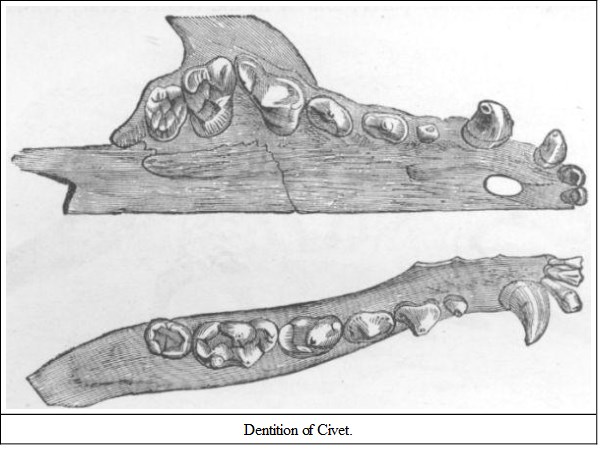
Dental formula: inc., 3—3/3—3; can., 1—1/1—1; premolars, 4—4/3—3; molars, 2—2/3—3.
The family contains the Civet, Genette, Linsang, Suricate, Binturong and Mongoose, though this last is separated by Jerdon, who follows Blyth.
GENUS VIVERRAAnal pouch large, and divided into two sacs secreting the civet perfume of commerce; pupil vertical and oblong; fur spotted and coarse, lengthened into an erectile mane on the back; diet mixed carnivorous and vegetivorous.
NO. 221. VIVERRA ZIBETHAThe Large Civet Cat (Jerdon's No. 119)NATIVE NAMES.—Katas, Hindi; Mach-bhondar, Bengali, also Bagdos and Pudo-gaula in some parts; Bhran in the Nepal Terai; Nit-biralu, Nepalese; Kung, Bhotia; Saphiong, Lepcha, (Jerdon); Khyoung-myen, Aracanese.
HABITAT.—According to Jerdon this species inhabits Bengal, extending northwards in Nepal and Sikhim, and into Cuttack, Orissa, and Central India on the south, but is replaced in Malabar by the next species; it is also found in Assam and Burmah, but apparently not in Ceylon, where V. Malaccensis represents the family.
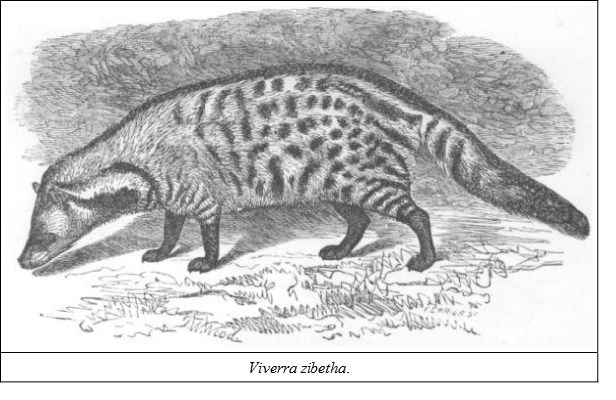
DESCRIPTION.—Hoary or yellowish grey, generally spotted and striped with black; some specimens are marked with wavy bands, others are almost free from marks; throat white, with a transverse black band, another on each side of the neck; under-parts white; tail with six black rings; limbs dark.

